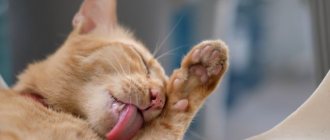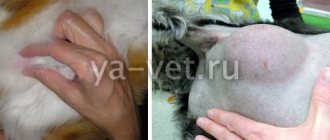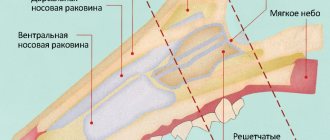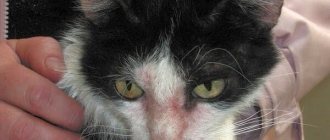The appearance of subcutaneous lumps on the body of a pet is an alarming sign that requires mandatory diagnosis. The wide variety of possible causes precludes any attempt at self-treatment. An incorrectly selected technique can harm the pet and worsen its well-being.
Despite the danger of possible consequences, do not panic. Many neoplasms are benign. For an accurate result, a thorough examination at a veterinary clinic will be required.
The main reasons for the appearance of lumps on the stomach of cats
The causes of a lump under the skin in a cat can be harmless. These include:
- Small balls that form after an injection. They do not pose any danger, since without any treatment they resolve on their own over time.
- Consequences of a wasp or other insect bite.
- Mats on wool. Of course, it’s difficult to mistake them for a bump, but this option also happens.
However, there are more serious types of formations. If after the appearance of one bump new ones begin to appear, then this can be a very bad sign. It is likely that this is a malignant formation. But there is no need to rush with premature species.
Hygroma
Or a synovial cyst is a swelling of tissue with saturation with serous fluid.
It looks like a painless swelling with fluid inside, but if an infection joins it, ulcerations and discharge appear. And when it grows to a large size, it can interfere and hurt when moving.
The veterinarian may prescribe removal of the contents of the cyst and the introduction of anti-inflammatory drugs in its place, but surgery is rare.
Types of subcutaneous formations and their symptoms
| Name of education | Type of education |
| Breast cancer | A malignant disease. Very often the prognosis is unfavorable |
| Lipoma (wen) | The tumor is benign and has the ability to spread |
| Skin formations | Depending on the type, they are divided into benign and malignant. These include papillomas, fibromas, sarcomas |
| Inflammatory process in the lymph nodes | The cause is inflammation of the lymph node |
| Hernia | It can be localized in the groin, navel, and perineum. Internal organs protrude under the skin |
| Inflammation of the mammary glands | Purulent process in the mammary glands |
| Complication after surgery | Often manifests itself in the form of a hernia. Cause of improper stitching |
| Skin diseases | Formation of follicles, carbuncles, purulent abscess |
So, there can be many reasons why a lump appears under the skin. And this is not uncommon for cats. But the nature of such education can be very different.
Benign
If a pet develops a benign lump, there will be no changes in behavior or eating habits. The animal does not experience any painful sensations, and the formation itself is soft if you touch it.
- Syringoepithelioma. Appears in the abdominal area in the form of a lump. The cause of formation is a violation of the activity of the sweat glands. Does not cause pain and does not grow.
- Wen (lipoma). Can vary in size and is formed from fat reserves. Has no tendency to metastasize. If it begins to cause concern to the animal, it is removed through surgery.
- In most cases, hemangioma is a congenital disease. The place of formation is the blood vessels located under the skin.
- Benign formations in the prostate area in uncastrated cats that do not live a natural life are common. Adenoma is a growth in the form of nodules that can be compared in appearance to cauliflower. Localization may vary. The disease has a likelihood of degenerating into oncology.
Benign formations can pose a danger to the animal. So a “harmless” lipoma can cause lameness or suffocation in a cat. Therefore, they cannot be left without attention.
Malignant
They have several alarming manifestations. Very often the skin in the place where the lump forms becomes hot. Over time, it begins to grow, and the cat begins to show signs of malaise (loose stools, nausea, fever). The appearance of ulcers and purulent discharge from the lump should be especially alarming. There are quite a few types of such tumors.
Others
There are other types of neoplasms. These include:
- Cysts. They are a round ball with watery contents. The boundaries of education are clear. The animal does not experience any pain. However, they can increase in size and reach larger sizes over time.
- Inflammatory process in the paraanal glands. It appears in the form of balls located under the skin. Interferes with the activity of the excretory organs. The disease is inflammatory in nature, the animal cannot relieve itself, and the activity of the secretory glands is disrupted. Outwardly, it is easily confused with a hernia, but it can increase in size depending on the position of the animal’s body.
- Eosinophilic granuloma. It appears as a red formation on the skin. Has a tendency to quickly spread to tissues located in the vicinity. It looks like a wet wound affected by microorganisms.
Mastitis
It is a consequence of early weaning from a nursing mother, sometimes - diseases of the genital organs, damage to the nipples or false pregnancy.
The mammary glands become inflamed and swollen, become hard and hot, and the body temperature rises. This is what a Sphynx cat looks like:
If a nursing female is sick, milk may not be released or will come along with pus. The doctor, after the necessary tests, will make sure that there is no cancer and will prescribe treatment.
If the illness is mild, he will prescribe compresses and massages at home; if it is severe, he will prescribe medications, including antibiotics, or even surgery.
Mastopathy in cats
Mastopathy in cats
It is a benign formation in the mammary glands of cats. As the formations progress, they can degenerate into oncology. The disease leads to a deterioration in the pet’s well-being. It responds well to treatment in the initial stage.
Causes
Most often, the cause of the pathology is a hormonal imbalance. The trigger can be pregnancy, including false pregnancy, various gynecological diseases, mammary gland injuries, abortion in cats.
Forms of the disease
There are several types of the disease.
- In the diffuse form, small nodules of connective tissue are formed;
- The nodular form is manifested by the appearance of foci of compaction;
- In the mixed form, cysts and a process in the form of fibrosis are formed.
In addition, there are several stages of the disease. Depending on the characteristics of the course.
Symptoms
The first signs of the disease very often go unnoticed. However, you may notice changes in the animal's behavior. It loses its appetite, becomes lethargic, constantly licks its nipples, and aggression may appear for no apparent reason.
As the disease progresses, nodules begin to form in the cavity of the mammary glands, and the mammary glands themselves become painful. Gradually, the process invades the lymph nodes; discharge may appear in the form of a cheesy mass, in which blood and pus are present. The animal refuses to feed the kittens and meows.
Diagnosis of pathology
If you suspect, you should show your pet to a specialist. The diagnosis is made by examination by palpation. In addition, tests and a number of examinations, for example, ultrasound, are prescribed. To clarify the nature of the formations, a biopsy is performed.
Treatment and prevention
At the initial stage, treatment is carried out at home. If this is a recently lambed cat, then it is transferred to dry food and the amount of water is reduced. Kittens are transferred to artificial feeding. The doctor prescribes drug therapy and necessary manipulations. Severe forms are treated surgically. The danger of the disease is that in an advanced stage it develops into oncology.
The method of prevention is regular examination of the animal, protecting it from injury, as well as timely treatment of concomitant diseases.
Furuncle
This is not just an abscess - inflammation of the epithelium, but a disease (in acute or mild form) caused by decreased immunity and focal damage to the hair follicle. It is purulent and necrotic in nature, caused by white or aureus staphylococcus, and begins with a red tubercle:
Gradually, the sore increases, fills with pus, becomes painful, body temperature rises, apathy and loss of appetite are possible. The lesions affect some or all parts of the body, or isolated ones.
Under the skin, the pus is located, as it were, in a “vessel” that restrains the boundaries of inflammation, and after “ripening” one (or several) gray dots will be visible from above - the rod.
Do not squeeze out the boil! Otherwise, the pus will spill over the adjacent tissues.
The veterinary clinic will do everything you need, and in the case of a chronic form, they will prescribe antibiotics.
Keep a sick animal especially clean by placing disposable diapers on top of the bedding every day. Don't bathe! Trim the fur from the site of inflammation, apply ichthyol ointment or Vishnevsky, wipe with alcohol while changing the compress, give an anesthetic. In case of spontaneous opening of the sore, clean it as much as possible from pus (do not press!) and reapply a bandage with ointment, changing it every 4-6 hours until the wound is completely cleansed.
Breast cancer in cats
One of the causes of mammary gland cancer in cats is advanced mastopathy. Most often diagnosed in older animals. In rare cases it occurs in cats, however, it has its own specifics. There are several types of cancer in cats.
Causes
As already mentioned, one of the reasons for the development of oncology in cats is advanced mastopathy. Cats develop intraepithelial cancer. The process develops due to the degeneration of epithelial or connective tissue cells. Depending on the type of cells that served as the “building material,” several types of cancer are distinguished.
Tumor stages
There are 4 stages of the disease. In the initial stages, the tumor is small. Therefore, very often the disease is not detected immediately. At stages 1 and 2, the animal eats normally, behaves actively, and does not show signs of anxiety. At the initial stage, the lump in the chest is no more than 1 cm. Closer to the second stage, its size can reach 3 cm.
The third stage is manifested by a significant increase in tumor size. It can already reach 5 cm. At the same time, the process of metastases begins. The lump changes a lot. Ulcers and wounds with bloody discharge may form on it.
The last stage is manifested by the active process of metastasis formation, as well as tumor disintegration. It can open and release contents with an unpleasant odor. In addition, the animal sharply loses weight, loses its appetite, and quickly weakens.
Clinical signs
It is not always possible to suspect the development of the disease from them:
- Slight increase in temperature;
- Bloody discharge appears;
- Ulcers and wounds may appear on the surface of the tumor;
- The animal experiences pain in the mammary glands;
- Rapid weight loss and lack of appetite are alarming signs;
- Minor lumps can be found under the skin.
Treatment methods
First of all, the cat undergoes surgery to remove the tumor. Often together with the affected organ. After this, chemotherapy is prescribed. It is worth remembering that a pet has the greatest chance of survival only at the initial stage. In a neglected state, it is doomed to death.
Prevention measures
According to experts, the only method of prevention is sterilization. After the very first heat. The animal should be examined regularly, and after 10 years of age, show it to a doctor.
What to do to get rid of the tumor?
Enlarged formations are subject to mandatory removal.
If the lump on the nose, near the ear or neck is benign, stable and does not bother the animal, the veterinarian will advise simply observing it. Sometimes such tumors resolve on their own, without special treatment. The growths, which gradually grow and compress the surrounding tissues, are removed surgically using local anesthesia. To prevent infection in the postoperative period, a course of antibacterial therapy is required.
A common method for removing tumors of benign etiology is freezing with liquid nitrogen. This method is preferable for an old pet, because it will help minimize trauma.
If a cat has a lump on its neck that is malignant in nature, and the disease is diagnosed in a timely manner, surgical removal is prescribed, during which nearby tissues are also excised. This way, it will be possible to get rid of cancer cells and prevent relapse. Ancillary antitumor therapies such as chemotherapy and radiation are extremely rarely prescribed to cats. After surgery, a restorative treatment regimen is selected for the animal.
Other possible causes of belly bumps
Not in all cases, the cause of the appearance of lumps is oncology. These formations can be caused by inflammatory skin diseases and various types of hernias.
Inflammation of the skin
Bumps on the skin due to inflammatory diseases may vary in size.
Wen (lipomas)
Formed in the fatty layer of the skin. It is a round formation, sometimes in the form of an oval. When palpated, it rolls. It does not cause metastases, however, it has the ability to grow. May pose a danger to the animal depending on its location.
Hernias
May have different sizes. They can be as small as a pea in size. The most common area is the umbilical area, and can form in the groin. Lead to pinching of internal organs. Requires treatment.
Abscess in cats
This lump has purulent contents. The formation process itself is accompanied by increased temperature. Hair loss occurs in the area of formation. If left untreated, the lump may rupture over time, leading to blood poisoning.
Lymphadenitis
The disease is manifested by inflammation of the lymph node. The affected node is characterized by swelling and immobility. The animal is in severe pain. The structure of the node is dense and has an oblong shape.
Ticks
A tick bite is often accompanied by an allergic reaction in the pet. It is caused by certain substances in the saliva of ticks. In response to a bite, a small bump appears on the cat’s body. The animal does not experience any painful sensations. The lump does not grow and may be itchy.
Scratches
A scratch is a damage to the skin. The affected area may become infected with germs. This leads to the development of an inflammatory process, which manifests itself as a lump. This is why scratches need to be treated, even if they seem harmless.
Mastitis
Mastitis in cats manifests itself in the form of small lumps that form on the nipples. As they grow, the size of the mammary glands increases, redness is observed, and the skin in the affected area will be hot. If treatment is not started in a timely manner, mastitis becomes a purulent process. Treatment requires antibiotics. Therefore, you will have to stop feeding kittens.
Hematomas
Bruises are manifested by minor hemorrhages under the skin. A lump often forms at the site of the injury.
Skin diseases
Various inflammatory processes often form on the surface of the skin. During the inflammatory process, a boil forms in the hair follicle. Over time, it opens and pus appears.
Carbuncle is also an inflammatory skin disease. The location can be any part of the body. May be large in size. Accompanied by the discharge of pus.
Risk factors
Older animals are most vulnerable to the appearance of tumors on the skin. Over time, their immunity decreases and the body becomes more vulnerable to various diseases. The risk of developing cancer increases.
Other risk factors can be identified:
- Bad ecology.
- Heredity.
- Incorrect and poor quality nutrition.
- Constant stress.
- Mechanical injuries.
- Parasitic infestation.
- The presence of other chronic diseases, which reduces immunity.
- Allergy.
- Inflammatory processes in the body.
- Hormonal disorders (often found in unsterilized animals).
- Insect bites.
Diagnosis and treatment of cones
If you find bumps in your cat, you should show your pet to a specialist. It is very important to establish an accurate diagnosis of the animal in a timely manner. Treatment for the lump will depend on the diagnosis. The sooner the cause of the bump is determined, the more effective the therapy will be. If oncology is detected, remission can only be achieved by treating the disease at an early stage.
Basic and additional therapy
Therapy is prescribed depending on the diagnosis. It is aimed at eliminating the underlying disease. Purulent bumps on the body are opened in a veterinary clinic. To eliminate inflammation, a course of antibiotics is prescribed. In addition, it is necessary to treat the affected areas with antiseptic drugs. If a diagnosis of oncology is established, then therapy is chosen according to a different principle. First, the animal’s tumor is removed, then treatment is selected according to the appropriate regimen.
What to do with purulent and bleeding seals?
If a purulent seal forms, you need to show your pet to a specialist. Treatment of such a serious inflammatory process as an abscess should be carried out in a hospital setting. It is dangerous not only due to the formation of pus, but also by poisoning the cat’s body with decay products.
The abscess is opened by a doctor and treated with special solutions. The doctor places drainage tubes.
Bleeding lumps require examination in a clinic. Because it is necessary to establish the cause of their formation.
Precautionary measures
If the lump under the skin turns out to be a tick, contact your veterinarian immediately. The most dangerous parasites carry encephalitis, so if treated independently, not only the cat, but also the owner may suffer. First aid is recommended only when an urgent visit to a veterinary clinic is not possible. To do this, strictly follow the instructions for removing ticks. If you don’t know her, contact your doctor by phone. Improper removal may result in blood poisoning.
Never squeeze out cones with purulent contents. Damage to such seals leads to infection of deeper layers of cellular tissue and a severe form of abscess.
In the later stages of cancer, the likelihood of saving the animal is minimized. If you want to protect your sick pet, sign up for a veterinary clinic for diagnosis immediately after detecting subcutaneous lumps.
A tumor on a cat's stomach can be of different types.
So, the formation of a tumor on a cat’s abdomen is a common occurrence. It can be benign or malignant in nature. Depending on what tissue turned out to be the “building material,” malignant tumors come in different types.
In males, a fairly rare type of cancer occurs - intraepithelial. Cancer in females also varies. It could be carcinoma. It is formed from epithelial tissue. Another type is adenocarcinoma. Its “building material” is glandular tissue.
Recommended clinics
If you find lumps on your cat’s belly, you should contact a clinic that immediately has a surgeon, oncologist and dermatologist to quickly determine the cause and further treatment.
Moscow
- Veterinary clinic White Fang. There is a branch in Kaliningrad. They work around the clock. There is an MRI machine. There is an oncology department.
- Network of veterinary clinics Medvet. Vilkovysky I.F. – chief physician, head of the surgical department, leading surgeon. Candidate of Veterinary Sciences.
- Veterinary center Komondor. Wide range of veterinary services. There is an animal rehabilitation unit. The clinic’s doctors are active participants in veterinary conferences and symposiums.
Saint Petersburg
- Vetus veterinary clinic network. Oncologist Tamoshkin D.A. – chief physician, lecturer at St. Petersburg veterinary surgical conferences.
- Pride Cancer Center. MRI available. Chief physician Bryushkovsky K.Yu. He is a candidate of veterinary sciences and teaches at the St. Petersburg State Academy of Veterinary Medicine.
Murmansk
- Animal care. The clinic has been operating since 2006. Chief physician Ivaneeva O.E. – a general specialist.
- Clinic Ivetas. The first clinic in Murmansk with equipment for endoscopic operations and other types of research.
- Veterinary clinic Favorit. Conducts a wide range of diagnostic and therapeutic procedures. Cooperation has been developed with the Clinic of Neurology and Intensive Care of Dr. V.V. Sotnikov, St. Petersburg, and the White Fang Clinic, Moscow.
Read other articles about cats on the Guardian of Purity portal. Stay with us!
Quantity
How to prevent stomach tumors in cats
Unfortunately, there is no way to prevent the development of tumors. However, it is possible to keep your pet healthy for as long as possible. To do this, you need to organize the right diet for her. It does not include leftover food from the owners. The animal should be fed only with specialized food.
You can add vegetables and fruits to your diet; they are seasoned with vegetable oil. Food is selected depending on the age category, as well as taking into account the state of health. It is very important to prevent the occurrence of stressful situations for the animal.
Insect bite
No, not butterflies. Painful swelling can only be caused by the bite of stinging insects!
Remove the sting with tweezers, rinse with a soda solution (a teaspoon per glass of water) and apply a cold compress to relieve swelling.
To prevent allergies, give ¼ tablet of Tavegil or Suprastin twice a day, and if the condition worsens, go straight to the clinic, and even more so if there are a lot of bites, because then death is not far away.











